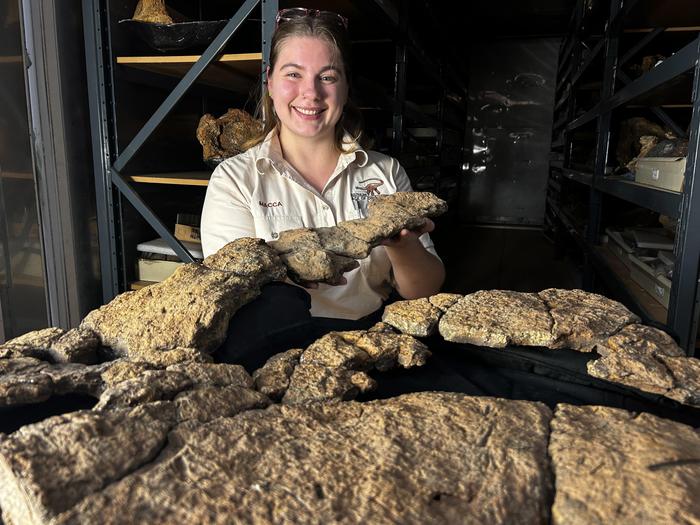
A groundbreaking discovery has shed new light on the dietary habits of sauropod dinosaurs, resolving a mystery that has perplexed paleontologists for decades. Researchers have uncovered fossilized gut contents from a mid-Cretaceous sauropod, providing the first direct and tangible evidence of what these massive creatures subsisted on nearly 100 million years ago. This remarkable find, detailed in a study published in the prestigious journal Current Biology, offers unprecedented insight into the feeding ecology and digestive biology of one of the most iconic groups of herbivorous dinosaurs.
Despite the vast array of sauropod fossils unearthed worldwide, genuine evidence of their gut contents—or cololites—had eluded scientists until now. The presence of intact cololites is exceptionally rare because digestive remains typically degrade before fossilization can occur. The discovery was made during an excavation at the Australian Age of Dinosaurs Museum of Natural History, where a relatively complete subadult Diamantinasaurus matildae skeleton was being carefully prepared. Embedded within the abdominal cavity, researchers identified a fractured rock layer harboring an assemblage of remarkably well-preserved plant fossils, solidifying the connection to the dinosaur’s last meals.
Microscopic and chemical analyses of the cololite revealed a diverse collection of plant matter, including conifer foliage, seed-fern fruiting bodies, and leaves from early flowering plants, or angiosperms. The combination of these plant groups highlights the indiscriminate feeding strategy employed by Diamantinasaurus, supporting the long-standing hypothesis that sauropods were bulk feeders consuming whatever vegetation was available within their reach. This strategy correlates closely with their enormous body sizes and relatively simple oral processing capabilities.
.adsslot_FRyV9Zz2Op{width:728px !important;height:90px !important;}
@media(max-width:1199px){ .adsslot_FRyV9Zz2Op{width:468px !important;height:60px !important;}
}
@media(max-width:767px){ .adsslot_FRyV9Zz2Op{width:320px !important;height:50px !important;}
}
ADVERTISEMENT
One particularly striking aspect of the study is the evidence for minimal oral processing by the sauropod. The fossils inside the gut contents show plants were likely severed or bitten but not extensively chewed. This observation indicates that Diamantinasaurus relied predominantly on fermentation and a complex gut microbiota to break down fibrous plant materials. Such a digestive mechanism mirrors that of some modern herbivores, like ruminants, which depend on microbial symbionts to liberate nutrients from otherwise indigestible cellulose.
Chemical biomarkers detected within the gut contents further corroborate the botanical diversity in the sauropod diet. The presence of biomarkers characteristic of both gymnosperms (conifers and seed ferns) and angiosperms indicates that sauropods were not specialized feeders but rather opportunistic browsers. This flexibility likely conferred a significant ecological advantage, enabling them to exploit a wide range of plant resources across different habitats and climatic conditions during the Mesozoic Era.
Perhaps the most surprising element of this discovery was the inclusion of angiosperm material, flowering plants that were emerging and diversifying during the mid-Cretaceous. Prior to this find, the extent to which sauropods incorporated angiosperms into their diets was speculative. The data now confirms that sauropods had adapted to these novel plants relatively soon after their evolutionary radiation, broadening our understanding of dinosaur-plant coevolution during this dynamic period of Earth’s history.
The researchers propose that the feeding strategy of Diamantinasaurus evolved with growth stages. Juvenile sauropods, limited by their stature, would have consumed low-growing vegetation, while subadults and adults expanded their dietary niche to include taller plants. This ontogenetic dietary shift provided young sauropods access to easily digestible shoots, bracts, and seed pods, whereas adults could reach a broader spectrum of foliage, reflecting a sophisticated and adaptable foraging behavior.
This evidence supports the theory that massive sauropods exerted an immense influence on terrestrial ecosystems. Their indiscriminate bulk feeding would have affected plant community structure, distribution, and evolution. The study underscores the notion that sauropods were not passive consumers but ecological engineers, shaping vegetation patterns and nutrient cycling over millions of years.
However, the authors emphasize caution in extrapolating their findings too broadly. The gut contents represent a single snapshot from one subadult individual and may not comprehensively reflect species-wide or temporal dietary habits. Variables such as seasonality, local plant availability, and individual health could have influenced the specific plant assemblages consumed. Future discoveries of additional cololites will be essential to refining our understanding of sauropod feeding ecology.
This remarkable breakthrough was enabled by meticulous excavation techniques, combined with cutting-edge analytical methods such as microfossil identification, chemical biomarker assays, and comparative botanical analysis. These interdisciplinary approaches allowed researchers to reconstruct a detailed and nuanced picture of sauropod diet with a precision previously unattainable in paleontology.
In sum, this study offers the most direct and comprehensive evidence of sauropod herbivory to date, confirming hypotheses derived from morphological and ecological proxies. By illuminating the diets of these ancient giants, scientists can better understand their biology, evolutionary adaptations, and the roles they played within the complex ecosystems of the Mesozoic. This discovery not only enriches the narrative of dinosaur life on Earth but also advances the broader field of paleobiology by bridging fossil evidence with modern ecological principles.
Subject of Research: Sauropod dinosaur diet and digestive biology through analysis of fossilized gut contents
Article Title: Fossilized gut contents elucidate the feeding habits of sauropod dinosaurs
News Publication Date: 9-Jun-2025
References: Poropat et al., Current Biology, 2025
Image Credits: Stephen Poropat
Keywords: Dinosaur fossils, Fossil records, Plant fossils, Paleontology, Macrofossils, Microbiota
Tags: cololites and digestive remainsCretaceous dinosaur dietDiamantinasaurus matildae skeletondigestive biology of dinosaursfossil evidence of dinosaur mealsfossilized dinosaur gut contentsherbivorous dinosaur ecologypaleontology discoveries Australiaplant matter in sauropodsprehistoric plant fossilssauropod feeding habitssauropod herbivory research





